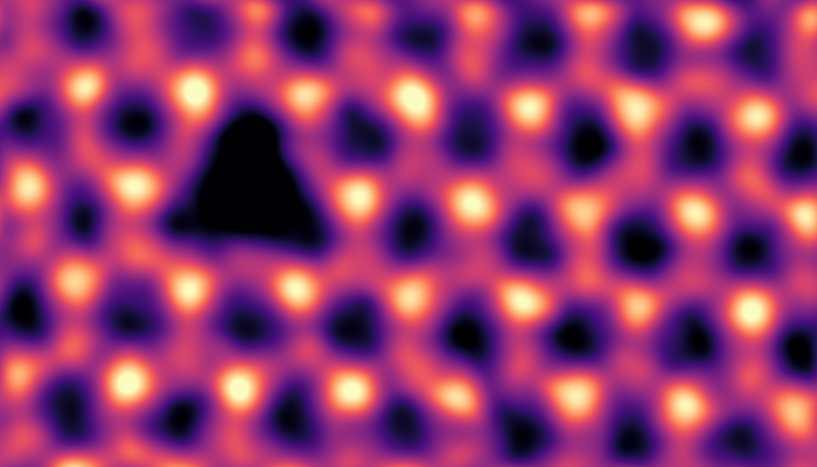Individual particles of light are used in quantum information processing, in information networks, and in sensors. It can radiate from defects in the atomic lattice of the atomically thin hexagonal boron nitride insulator. It has been hypothesized that missing nitrogen atoms are the atomic structure that could be responsible for this. However, it is difficult to remove them in a controlled manner. A team from the Faculty of Physics at the University of Vienna has now used a scanning electron microscope in very high vacuum to show that individual atoms can indeed be expelled. Results in the journal small published.
Transmission electron microscopy enables visualization of the materials’ atomic structure. It is particularly suitable for the direct detection of any defects in the atomic lattice of a material sample, which can be harmful or beneficial depending on the application. However, a high-energy electron beam can also damage the structure, either through elastic collisions or electronic excitations, or a combination of both. In addition, residual gases in the vacuum of the device can contribute to damage by causing broken gas molecules to slosh away from the atoms of the lattice. To date, measurements with transmission electron microscopy have been performed on hexagonal boron nitride (hBN), a boron-nitrogen compound, under relatively poor vacuum conditions, which also resulted in rapid deterioration. Because of all these limitations, it was not previously clear whether vacancies—the missing individual atoms—can be created in a controlled manner in the boron-nitrogen lattice.
Researchers at the University of Vienna have now succeeded in creating single-atom vacancies using aberration-corrected transmission electron microscopy in an ultrahigh vacuum of approx. The material was irradiated with a range of electron beam energies: at lower energies the damage is exponentially slower than at lower energies. At intermediate electron energies, single vacancies can be created from boron and nitrogen, with the boron atoms twice as likely to be ejected due to their lower mass. Atomically accurate measurements are not possible at the higher energies previously used to obtain hBN to emit single particles of light. However, the present results predict that, in contrast, nitrogen can be taken out more easily—so that glowing vacancies can be created preferentially.
Robust statistics gathered through rigorous experimental work combined with new theoretical models were crucial to these conclusions. Senior author Thuy An Bui has been working on the project since her master’s thesis: “With each electron power, I had to spend several days at the microscope and carefully collect one dataset after another,” she says. “Once we collected the data, we used machine learning to analyze it in detail, but this also took a lot of work.” Adds lead author Toma Susi: “To understand the mechanism of damage, we created an approximation model that combined ionization with strike damage. This allowed us to extrapolate to higher energies and shed new light on the formation of lattice defects.”
Despite the insulating properties, the results show that monolayer hexagonal boron nitride is surprisingly stable under electron irradiation if chemical etching can be avoided. In the future, it may be possible to use electron beam irradiation to create specific vacancies from which individual light particles will emit by selectively irradiating desired grating sites with a focused electron probe. New possibilities for previously demonstrated atomically precise manipulation of impurity atoms in graphene and in bulk silicon can also be highlighted.
The work was supported by the European Research Council (ERC) under the European Union’s Research and Innovation Program (No. 756277-ATMEN) and the Vienna Doctoral School of Physics (VDS-P). Open data and code will be provided with the release.
original post:
Thuy an Boy, Gregor T. Leuthner, Jacob Madsen, Mohamad Ra Monazam, Alexandru I. Scherita, Andreas Postel, Clemens Mangler, Jani Cutakowski, Toma Susi. Creation of single vacancies in HBN with electron irradiation. small (2023).
DOI: 10.1002 / smll.202301926
clarification:
Single nitrogen vacancies generated by electron beam irradiation in hexagonal boron nitride. In this filtered, stained scanning electron micrograph, the nitrogen atoms show lighter contrast and the void is visible as a triangular dark contrast at the top left. © Toma Susi / University of Vienna (CC-BY)

“Social media evangelist. Baconaholic. Devoted reader. Twitter scholar. Avid coffee trailblazer.”








More Stories
Longest jets in the universe discovered – giant particle streams as long as 140 Milky Way galaxies in a row
New method reveals 307 supernova remnants
Snapchat is upping the ante on augmented reality glasses